Types of Hickory Nuts (with Pictures) – Identification Guide For Hickory Nut Trees
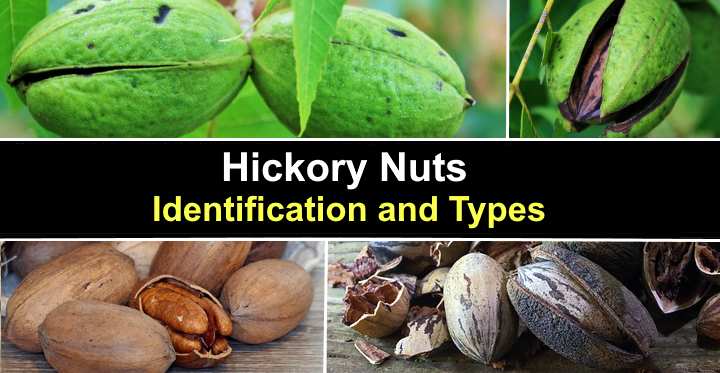
Hickory nuts are the fruits from the hickory tree (genus Carya). Most hickory nuts are edible and have a nutty, sweet taste reminiscent of a pecan nut—which is also a type of hickory nut. The delicious nuts from the hickory tree are surrounded by a hard shell and woody husk. The tastiest hickory nuts are from the pecan tree (Carya illinoinensis) and kingnut hickory (Carya laciniosa). However, the bitternut hickory (Carya cordiformis) and pignut hickory (Carya glabra) nuts taste bitter and are inedible.
This article is a comprehensive guide to the various types of hickory nuts. Descriptions and pictures of hickory nuts and hickory trees will help identify the tastiest nuts you may find where hickory trees are growing.
About Hickory Nuts

Hickory nuts (pecans)
Hickory nuts are categorized as a type of nut-like drupe called a tryna. This is because the nut has a hard shell that splits open, revealing a softer seed or fruit in the center.
Hickory nuts from individual species of trees have specific identifying characteristics. For example, nuts from the red hickory, shagbark hickory, or shellbark hickory are large nuts, generally round and measure between 1.2” and 2.5” (3 – 6.5 cm) in diameter. Other types of hickory nuts like the pignut hickory and pecan nuts are more oval or pear-shaped.
Hickory nuts can also be identified by the way the hard shell splits into four segments. Typically, when harvesting hickory nuts, you should look for nuts with the shell intact or just a slight split.
It takes about 25 to 30 years for a hickory tree to start producing nuts.
Are Hickory Nuts Edible?
Although all nuts from the hickory tree are edible and not poisonous, some have a bitter taste. You can eat hickory nuts straight from the shell to enjoy their nutty flavor. In addition, the delicious nuts are calorie-dense due to their high oil content. The sweetest hickory nuts taste like pecans or mild walnuts.
Hickory Nut Shell
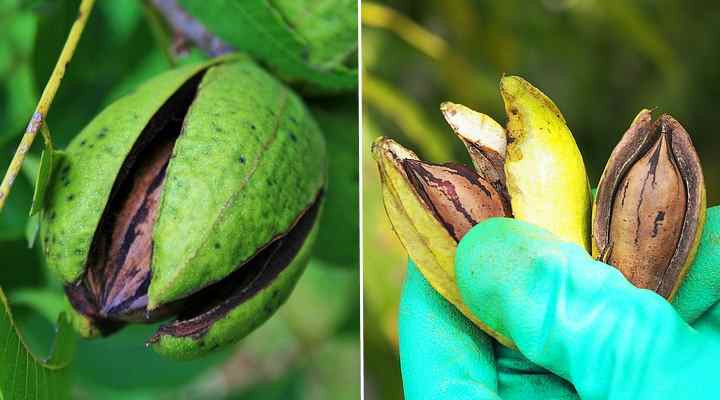
Hickory nuts have double nutshells with outer husk that splits to reveal an inner hard shell
Hickory nuts are double nutshells. They consist of fibrous greenish-brown outer husks that dry to a brown color as the nuts ripen on the tree. After ripening, the husk usually splits, revealing a hard, woody nutshell that is difficult to crack open. However, opening the nutshells from shagbark or kingnut hickories is worth it to taste the delicious buttery meat.
One of the issues when harvesting hickory nuts is breaking open the tough shell. They are literally “tough nuts to crack.” The nutshells tend to be smooth and slippery. Therefore, it’s best to crack hickory nuts open with a hammer or large stone. The best place to hit the nut is along the stem and then pull the meat out from the shell.
What To Do With Hickory Nuts
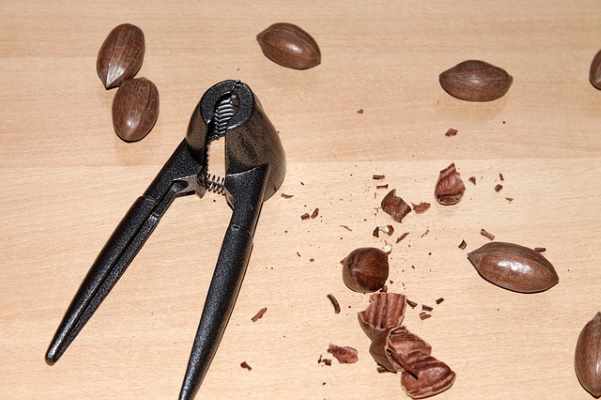
Hickory nuts are best eaten straight off the tree
You can use hickory nuts in place of pecan nuts or walnuts in cooking. Of course, the sweet, nutty flesh is delicious straight off the tree. However, you can separate the nuts from the shells and boil them to create hickory nut oil or hickory nut syrup.
For example, after boiling the nuts for 30 minutes in water, the nut oil will form a layer on the top. You can skim this off and use it as nut butter or baste roasts with it. Or boiling the nuts in some water and sugar can create hickory nut syrup.
Other ways to consume hickory nuts include roasting the nuts in a low heat in the oven.
But what can you do with the hard hickory shells? First, don’t throw them away. The woody nuts burn well, and you can burn them in the fireplace to enjoy the hickory aroma. Alternatively, you can throw some on the barbecue to add a southern flavor to cooked meat.
When Do Hickory Nuts Fall?
Hickory nuts ripen on the tree by the fall and drop to the ground after windy spells or autumn storms. Also, you can shake the nuts from trees. However, be careful about a barrage of large hard nuts landing on your head. Hickories produce bumper nut crops every three years.
Hickory Nut vs. Walnut
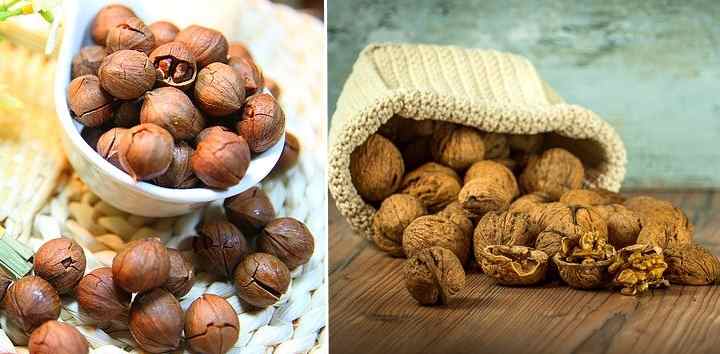
Hickory nuts (left) and walnuts (right)
Hickory nuts and walnuts have a similar taste because they are a related species in the family Juglandaceae. However, one difference between a hickory nut and a walnut is that hickory nuts have a harder outer husk. Also, hickory nuts tend to have smooth shells, whereas walnuts have a more wrinkled appearance.
You can also tell the difference between some hickory trees and walnut trees by looking at the bark. Hickories tend to have peeling, shaggy bark, giving the trunk a disheveled look. On the other hand, a walnut tree has a more solid bark that starts smooth gray and gradually develops rough fissures.
How to Identify Hickory Nuts
To identify hickory nuts, look at the shape and texture of the nut. A hickory nut can be heart-shaped, round, or oblong. The outer husk emerges green and turns brown when it’s ripe in the fall. Inside, a hickory nut reveals veined chambers containing sweet or bitter meat, depending on the species.
You can also identify species of hickory nuts by observing the tree’s characteristics. Hickory trees are identified by their long, pinnately compound leaves with large lance-shaped leaflets. The leaves can measure between 10” and 24” (25 – 60 cm) long. Many hickory tree species also have identifiable peeling gray bark.
Types Of Hickory Nuts (with Pictures) – Identification Guide
Let’s look in more detail at identifying the fruit from hickory trees, commonly referred to as hickory nuts.
Shellbark Hickory Nut / Kingnut Hickory Nut (Carya laciniosa)
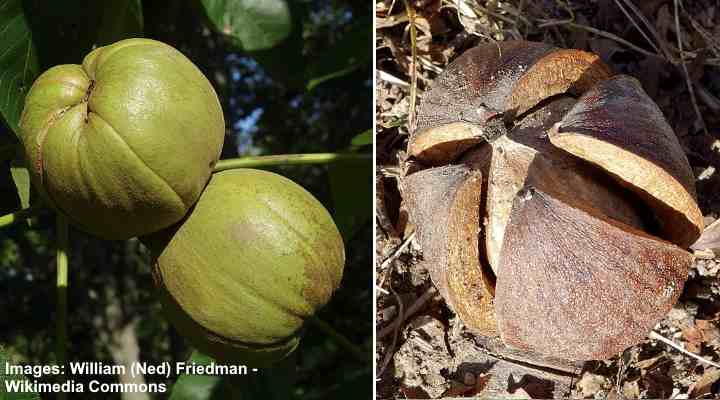
Shellbark hickory nut / kingnut hickory nut – immature nut (left picture) and mature nut (right picture)
The nut from the kingnut hickory tree is one of the tastiest hickory nuts and also the largest. The large round or oval nuts grow between 1.8” and 2.5” (4.5 – 6.5 cm) long and 1.5” (3.8 cm) across. A woody dark-brown shell covers a sweet kernel that tastes delicious.
An identifying feature of shellbark hickory nuts is the thick oval shell. This thick shell means that the kernel inside is relatively small compared to the king-sized hickory nut.
Shellbark Hickory Tree Nut Identification: To identify the shellbark hickory tree, look for the long narrow vertical scales that peel from the tree’s bark. Usually, shellbark hickory leaves have seven leaflets.
Shagbark Hickory Nut (Carya ovata)

Shagbark hickory nut (Carya ovata) – immature nut (left picture) and mature nut (right picture)
The nut from the shagbark hickory tree is a large, hard oval nut that measures 1.2” to 2” (3 – 5 cm) long. The identifiable features of the shagbark hickory nut are that it usually grows in pairs, is dark brown to black, and splits freely. Shagbark hickory nuts are exceedingly sweet.
If you plan on harvesting shagbark hickory nuts, remember that only the fallen nuts are ripe.
One way to help identify shagbark hickory nuts is by looking at the leaf shape. The pinnate leaves usually contain five leaflets that are short, oval, and have pointed tips.
Shagbark Hickory Tree Nut Identification: Shagbark hickory nuts can also be identified by observing the tree’s traits. The trunk is covered in thick, scaly bark that easily peels, giving the tree an unkempt appearance.
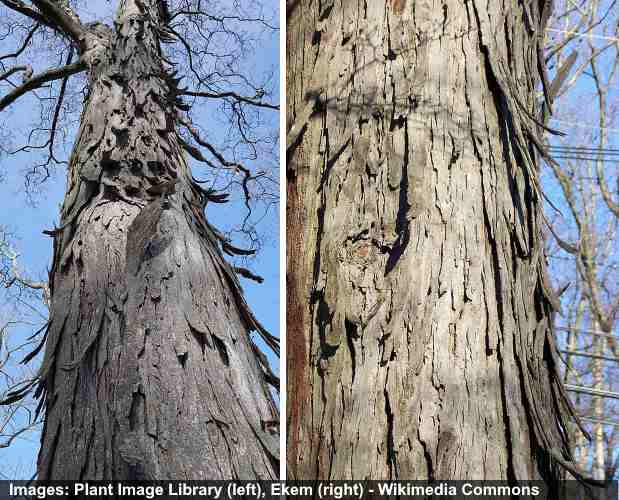
Shagbark Hickory tree (Carya ovata) bark
Southern Shagbark Hickory Nut (Carya carolinae septentrionalis)
The nut from the southern shagbark hickory is a light to dark brown egg-shaped nut that splits freely after falling from the tree. Southern shagbark hickory nuts measure up to 2” (5 cm) long and 0.8” to 1.6” (2 – 4 cm) across. Like nuts from Carya ovata and Carya laciniosa, the fruit is deliciously sweet.
Southern shagbark hickory nuts are usually easy to crack open. If you see hickory nuts on the ground split into four pointed segments, then the chances are this is a southern shagbark variety. Opening the nut’s shell reveals a light-brown sweet flesh.
Southern Shagbark Hickory Tree Nut Identification: The southern shagbark hickory has identifiable shaggy bark that peels in strips high up the tree.
Northern Shagbark Hickory Nut (Carya ovata var. ovata)
The nut from the northern shagbark hickory tree is a spherical nut with a slightly flattened top. The egg-shaped shagbark hickory nut is a light brown color and measures 1.5” (4 cm) long and 0.6” (1.6 cm) wide. The thin tan shell covers a sweet, edible nut inside.
Apart from oval, tan-colored nuts, other ways to identify the northern shagbark are pinnate leaves with five serrated leaflets.
Northern Shagbark Hickory Tree Nut Identification: The northern shagbark hickory tree has characteristic peeling bark that exfoliates in thin strips.
Pignut or Black Hickory Nut (Carya glabra)
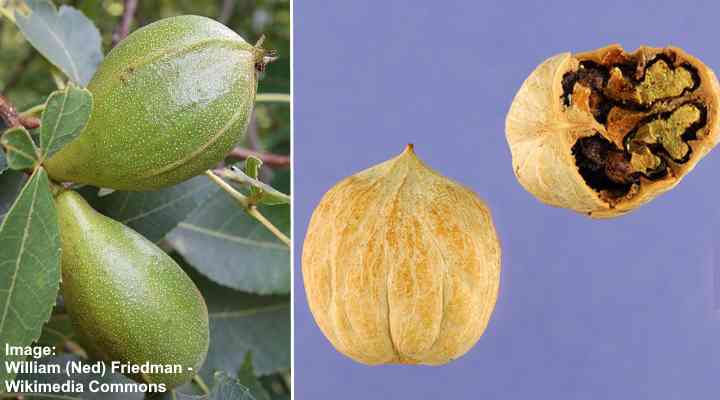
Pignut/black hickory nut (Carya glabra) – immature nut (left picture) and mature nut (right picture)
The nut from the pignut hickory tree is a pear-shaped nut with a green husk that turns light brown and ridged when ripe. The oval pignut hickory nuts measure 1” (2.5 cm) long and 0.75” (2 cm) across. Cracking the nut open reveals four chambers containing a bitter kernel.
Although it’s not a poisonous nut, the pignut hickory nut is not palatable. The meat is exceedingly bitter to taste and is not recommended for consumption. However, these hickory nuts are popular with wildlife like squirrels, rabbits, foxes, bears, and small mammals.
A feature of pignut hickory nuts is that they rarely split on their own.
Pignut Hickory Tree Nut Identification: The way to identify a pignut hickory tree is by its 12” (30 cm) compound leaves consisting of five to seven leaflets. The lance-shaped leaflets have finely serrated margins and measure up to 5” (12 cm) long and 2” (5 cm wide)
Mockernut Hickory Nut (Carya tomentosa)
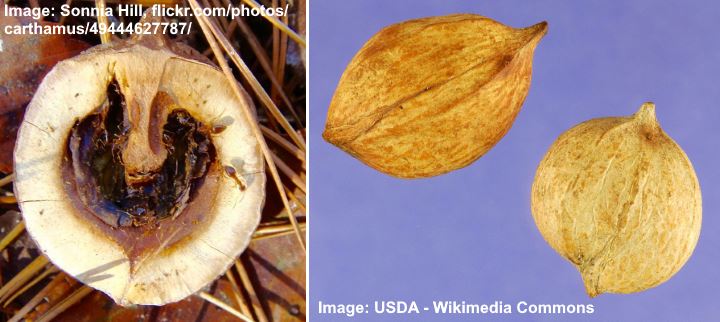
Mockernut hickory nuts (Carya tomentosa)
Also called the white hickory, the nut from the mockernut hickory is an oval, light brown nut-like drupe. A mockernut hickory nut measures 1.5” to 3” (3.8 – 7.5 cm) across. The thick husk covers a small edible nut that is difficult to extract. When mature, the hickory nut has four distinct ridges.
Other names for the Carya tomentosa are white heart hickory (referring to the tree’s wood) and squarenut (referring to the nut’s shape). The name mockernut comes from the difficulty of cracking open the nut, which reveals a tiny kernel that is hardly worth eating.
Mockernut Hickory Tree Nut Identification: You can identify a mockernut hickory tree by its thin, dark gray bark that becomes furrowed as it matures. The long hickory leaves are compound with five to seven ovate leaflets, measuring 6” (15 cm) long.
Bitternut Hickory Nut (Carya cordiformis)
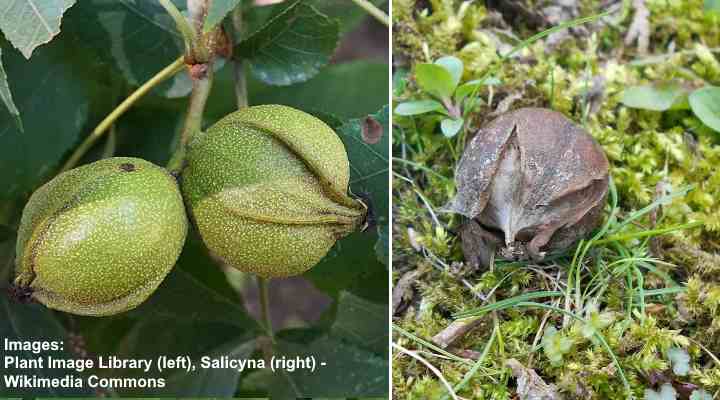
Bitternut hickory nut (Carya cordiformis) – immature nut (left picture) and mature nut (right picture)
As the name suggests, the nut from the bitternut hickory tree has a rancid taste, not suitable for eating. The round bitternut hickory nuts are a spherical shape and develop four ribs as they mature. The green husks dry dark brown and split, revealing a fig-shaped nut. The bitter-tasting inedible nuts measure 0.75” to 1.25” (2 – 3 cm) long.
Bitternut Hickory Tree Nut Identification: The identifying features of the bitternut hickory tree are its large leaves with seven to eleven leaflets, rounded hard nuts, and gray bark that develops ridges as it matures.
Red Hickory Nut (Carya ovalis)
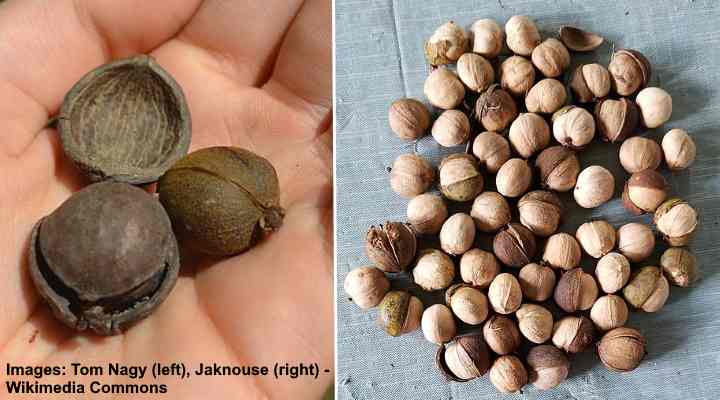
Red hickory nuts (Carya ovalis)
The nut from the red hickory tree is a round nut that develops a dark husk covering a tan-colored nut. The meat in the red hickory nut is creamy-white and typically has a sweet taste. However, it can sometimes be bitter. A red hickory nut measures 1” to 1.5” (2.5 – 3.8 cm) long.
Red Hickory Tree Nut Identification: A red hickory tree is identified by its gray, fissured bark, pinnately compound leaves with five to nine leaflets, and small rounded dark nuts growing in groups of two or three.
Sand Hickory Nut (Carya pallida)
The nut from the sand hickory tree is the smallest of the hickory nuts. The oval sand hickory nut has a pointed top and flattened bottom. The light brown, thin husk covers a small tan-colored nut that measures between 0.5” and 1.5” (1.3 – 3.8 cm) long. Sand hickory nuts have a sweet kernel inside.
A distinguishing characteristic of the sand hickory nut is its flattened, oval shape and thin shell. This hard shell covers brown meat that has a sweet taste. Sand hickory nuts are excellent substitutes for pecans.
Sand Hickory Tree Nut Identification: A sand hickory tree is identified by its relatively smooth bark with shallow furrows, narrow, lanceolate leaves, and tiny hickory nuts.
Scrub Hickory Nut (Carya floridana)
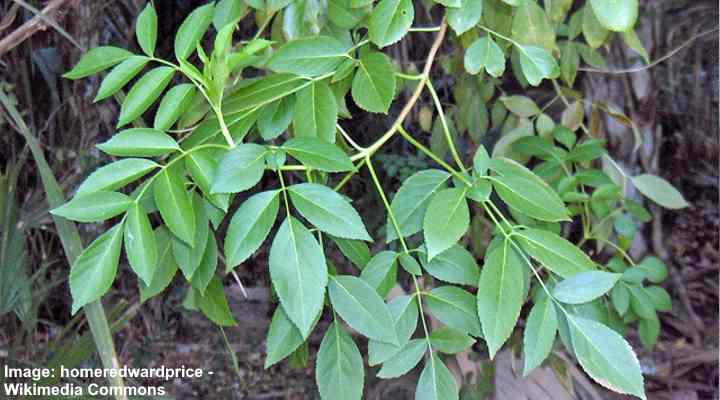
Scrub hickory (Carya floridana) leaves
The nut from the scrub hickory tree is a rounded spherical nut that grows in groups of three. The scrub hickory is native to Florida and its nut is classed as a sweet, tasty, edible hickory nut. The round nut is 1.2” – 1.6” about (3 – 4 cm) long and 0.8” to 1” (2 – 2.5 cm) in diameter.
The scrub hickory can grow as a multi-stemmed shrub-like tree 10 – 16 ft. (3 – 5 m) tall. As a single trunk tree, scrub hickory grows up to 80 ft. (25 m).
Scrub Hickory Tree Nut Identification: The scrub hickory tree is identified by its long 12” (30 cm) leaves consisting of three to seven lance-shaped leaflets.
Nutmeg Hickory Nut (Carya myristiciformis)
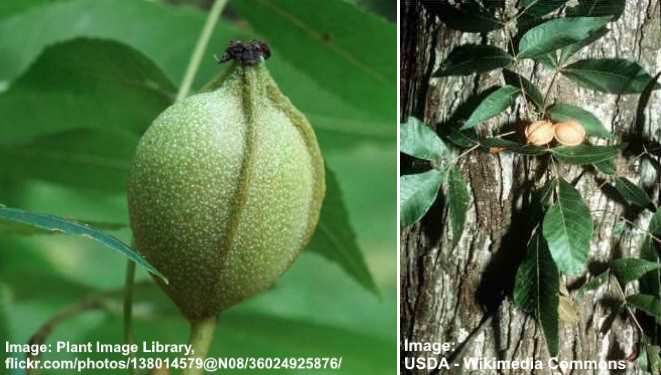
Nutmeg hickory nut (Carya myristiciformis) immature nut (left picture) and mature nut (right picture)
The nut from the nutmeg hickory tree is a rounded reddish-brown nut that has silvery stripes and speckles. Each nutmeg hickory nut measures around 1” (2.5 cm) long, and its thin husk develops four distinct ridges. The thick brown hickory nutshell surrounds a tasty, sweet kernel.
The common name of Carya myristiciformis comes from the fruit’s resemblance to the aromatic spice nutmeg Myristica fragrans. However, the nutmeg hickory nuts are not related to the spice.
Nutmeg Hickory Tree Nut Identification: The identifiable features of a nutmeg hickory tree are large, pinnately compound leaves measuring up to 14” (35 cm) long. There are five to nine leaflets, each with toothed margins. The nut-bearing tree has scaly, reddish-brown bark.
Pecan (Carya illinoinensis)
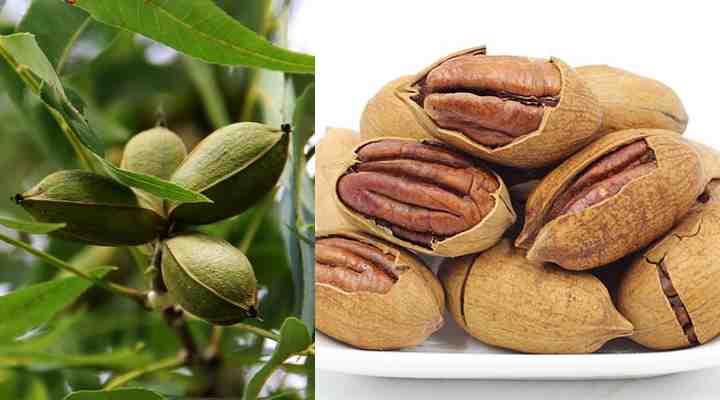
Pecan nut (Carya illinoinensis) – immature pecan nut (left picture) and mature pecan nut (right picture)
The nut from the hardy pecan tree is one of the most famous hickory nuts. The pecan nut is identified by its greenish-gold husk that has an oval to oblong shape. Pecan nuts measure 1” – 2.2” (2.5 – 6 cm) long and around 1” (2.5 cm) wide. The nut matures to a coppery brown color.
Pecan nuts have a sweet, buttery flavor. The edible part of the nut is an oblong, cylindrical shape and a dark brown color. Pecan nuts have characteristic ridges running lengthwise. Usually, the large nuts grow in groups of four. The fruit is divided into two halves inside the nutshell.
You can eat pecan nuts straight off the tree as a snack. In addition, the tasty nuts are used in baked goods, especially in the southern states of the US.
Pecan Tree Identification: The pecan nut tree is one of the largest hickory species growing up to 100 ft. (30 m). The way to identify a pecan tree is by its pointed leaflets growing on compound leaves. The fern-like pecan tree leaves grow up to 20” (50 cm) with between nine and 17 leaflets on a leaf.
Harvesting Hickory Nuts
Harvesting hickory nuts in the fall is popular in areas of woodlands and deciduous forests where hickories commonly grow. Although hickory trees produce nuts every year, most species have bumper crops every three years. During bumper years, the forest floor can be covered in hickory nuts.
After collecting plenty of hickory nuts, you should leave the nuts to dry in a warm area. Then, after two weeks, you can store the nuts in a cool place for up to one month. Or you can remove the meat from the shells and store the tasty nuts in the freezer, where they will keep for many months.
Find out how to identify hickory trees.
Related articles:
